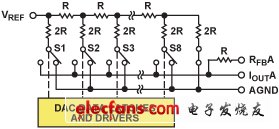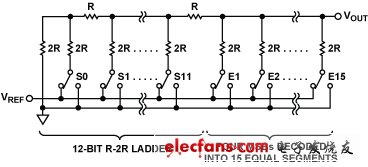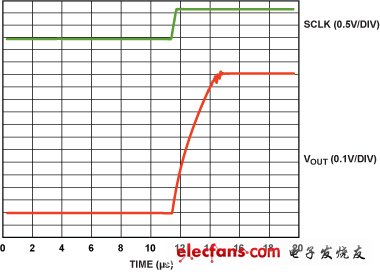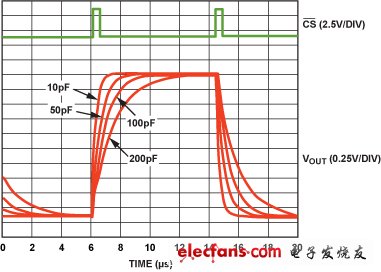This article examines a new precision 16-bit DAC and talks about the output buffer of a high-speed complementary current-output DAC that is comparable to a transformer.
Voltage-switching 16-bit DAC provides low noise, fast settling time and better linearity
Based on the breakthrough 10-bit CMOSAD7520, which has been in use for nearly 40 years, the resistor ladder multiplying DAC was originally used for inverting op amps, while the amplifier's summing point (IOUTA) provides a convenient virtual ground (Figure 1).

Figure 1. CMOS Multiplying DAC Architecture
However, under certain constraints, they can also be used to provide a voltage switch configuration for the in-phase voltage output where the op amp acts as a voltage buffer (Figure 2). Here, the reference voltage VIN is applied to OUT, and the output voltage VOUT is supplied by VREF. A 12-bit version optimized for this use appeared shortly afterwards.

Figure 2. Multiplying DAC in voltage switching mode
Fast advance to the present: With the increasing popularity of single-supply systems, designers face the challenge of controlling power consumption while maintaining performance levels at high voltages. There is also an increasing demand for higher resolution (up to 16 bit) devices that can be used in this mode.
A significant advantage of using a multiplying DAC in voltage switching mode is that no signal inversion occurs, so a positive reference voltage will result in a positive output voltage. However, when used in this mode, the R-2R ladder architecture also has a drawback. In the case of the same DAC for current steering mode, the non-linear resistance of the N-channel switch in series with the R-2R ladder resistor will cause the integral linearity (INL) to drop.
In order to overcome the shortcomings of multiplying DACs while maintaining the advantages of voltage switching, a new high-resolution DAC, such as the AD5541A, has been developed (see Figure 3). The AD5541A uses a partially segmented R-2R ladder network and complementary switches to achieve ±1-LSB accuracy at 16-bit resolution and no adjustment over the entire temperature range of ?40°C to +125°C. The noise value is 11.8 nV/√Hz, and the setup time is 1?s.

Figure 3. AD5541A architecture
Performance characteristics
Settling time: Figure 4 and Figure 5 compare the settling time of the multiplying DAC in voltage mode and the settling time of the AD5541A. When the capacitive load on the output is minimum, the setup time of the AD5541A is approximately 1?s.

Figure 4. Settling time of the multiplying DAC

Figure 5. Setup time of the AD5541A
Noise Spectral Density: Table 1 compares the noise spectral density of the AD5541A and the multiplying DAC. The AD5541A has a slightly better performance at 10 kHz and is very advantageous at 1 kHz.
Table 1. Noise Spectral Density of AD5541A and Multiplying DAC

Antenk D-Sub,D-Shaped Connectors Solutions offer a broad range of higher reliability D-Sub connectors.
Antenk's D-Sub product line is designed for applications that require a rugged, robust I/O connector system with various styles and mounting options. All are used in a variety of industries including computer, industrial, medical, and military markets.
Antenk High-Density D-Sub Connectors
Available in cable mount options including crimp & solder cup and the board mount options including Dip Solder, Wire Wrap, High Profile, Right Angle, & Surface Mount (SMT). This comprehensive Antenk High-Density Density D-Sub product offering is available in both stamped & formed and machined contact options.
High density D-Sub connectors, for applications where the best possible contact density is required. Due to the [high" density of the 15, 26, 44, 62 and 78 contacts, this series is ideal for the most modern applications. The insulating body, a monoblock, complies with the UL94 V-0 standard. The contacts are machined and available in several quality classes.
Antenk Solder Type D-Sub Connector
Available in standard and high density versions
Supplied with stamped & formed or screw machine contacts.
Standard contact terminations accomodate up to 20 AWG standard wire
Available with white (nylon) or black (PBT) insulators. Standard shell plating is tin
Antenk D-Sub connectors solder cup machined contacts are manufactured according to the standards MIL-C-24308 and DIN 41652. The standard connectors from Antenk are available in all known versions and sizes. They are available in various version with numerous assemblies. The insulating body, a monoblock, complies with the UL94 V-0 standard. The contacts are machined and available in several quality classes.
Features of Antenk's Solder Cup Standard D-Sub Connector Machined contacts
Solder cup d-sub available in 5 industry sizes/positions
Standard Density ( 9 pin , 15 pin , 25 pin , 37 pin , 50 pin)
Tin shells have indents to provide grounding and additional retention.
Screw machine contacts offer high reliability. Non-removable contacts.
Optional mounting hardware available.
Materials of Antenk Solder Cup Standard D-Sub Connector Machined contacts
Shell: Steel, tin plated
Insulator: Glass-filled thermoplastic. U.L. rated 94V-O
(260°C process temp)
Machined contacts:
Male pins - Brass | Female pins - Brass
Plating: Gold flash on entire contact
Contact us for other plating options
Features of Solder Cup High Density D-Sub Machined Contacts
Solder cup d-subs in 4 industry sizes/positions
High Density (15 pin, 26 pin, 44 pin, 62 pin).
Approximately 65% more higher density then standard d-sub connectors.
Screw machined contacts offer high reliability.
Metal Shell provides EMI/RFI shielding. Available in 3 clinch-nut options.
Plug shells have indents to provide grounding & additional retention.
Connectors will fit in standard D-Sub Backshells .
Contacts will accept (28 - 24) gauge wire.
Materials of Solder Cup High Density D-Sub Machined Contacts
Shell: Steel, Nickel plated
Insulator: Glass-filled, PBT Thermoplastic. U.L. rated 94V-O
(230°C process temp)
Machined contacts: Brass, Gold Flash Plated(contact us for other plating options)
9 pin, 15 pin, 25 pin, 37 pin, 50 pin Male Solder Cup Standard D-Sub Connectors Machined Contacts, Solder Cup High Density D-Sub Machined Contacts,Female Solder Cup Standard D-Sub Connectors Machined Contacts
ShenZhen Antenk Electronics Co,Ltd , https://www.antenk.com